
Anti‑inflammatory effects of Daehwangmokdantang, a traditional herbal formulation, in lipopolysaccharide‑stimulated RAW 264.7 macrophages
- Authors:
- Moon Hee Lee
- Su Hyun Hong
- Cheol Park
- Min‑Ho Han
- Sung Ok Kim
- Sang Hoon Hong
- Gi‑Young Kim
- Yung Hyun Choi
-
View Affiliations
Affiliations: Department of Biochemistry, Dongeui University College of Korean Medicine, Busan 614‑052, Republic of Korea, Department of Molecular Biology, College of Natural Sciences and Human Ecology, Dongeui University, Busan 614‑714, Republic of Korea, Natural Products Research Team, National Marine Biodiversity Institute of Korea, Seocheon 325‑902, Republic of Korea, Department of Food Science and Biotechnology, College of Engineering, Kyungsung University, Busan 608‑736, Republic of Korea, Department of Internal Medicine, Dongeui University College of Korean Medicine, Busan 614‑052, Republic of Korea, Laboratory of Immunobiology, Department of Marine Life Sciences, Jeju National University, Jeju 690‑756, Republic of Korea
- Published online on: October 12, 2017 https://doi.org/10.3892/etm.2017.5296
-
Pages:
5809-5816
-
Copyright: © Lee
et al. This
is an open access article distributed under the
terms of Creative
Commons Attribution License.
Metrics:
Total
Views: 0 (Spandidos Publications: | PMC Statistics:
)
Metrics:
Total PDF Downloads: 0 (Spandidos Publications: | PMC Statistics:
)
This article is mentioned in:
Abstract
Daehwangmokdantang (DHMDT) is a traditional polyherbal formulation that has known antidiarrheal and anti‑inflammatory activities. However, the underlying mechanisms of these activities are poorly understood. In the present study, the inhibitory effects of DHMDT on the production of proinflammatory mediators and cytokines in lipopolysaccharide (LPS)‑stimulated RAW 264.7 macrophages were investigated. The inhibitory effects of DHMDT on LPS‑induced nitric oxide (NO), prostaglandin (PG)E2, tumor necrosis factor (TNF)‑α and interleukin (IL)‑1β production were examined using Griess reagent and ELISA detection kits. The effects of DHMDT on the expression of inducible NO synthase (iNOS), cyclooxygenase (COX)‑2, IL‑1β and TNF‑α, and their upstream signal proteins, including nuclear factor (NF)‑κB, mitogen‑activated protein kinases (MAPKs) and RAC‑α serine/threonine‑protein kinase (Akt), a phosphatidylinositol 3‑kinase (PI3K) downstream effector, were investigated using western blotting and immunofluorescence staining. The results revealed the pretreatment with DHMDT significantly inhibited the LPS‑induced production of NO, PGE2, TNF‑α, and IL‑1β, and expression of iNOS, COX‑2 TNF‑α, and IL‑1β, without any significant cytotoxicity. DHMDT also efficiently prevented the translocation of the NF‑κB subunit p65 into the nucleus by interrupting the activation of the upstream mediator inhibitor of NF‑κB kinase α/β. Furthermore, the anti‑inflammatory effects of DHMDT were associated with the suppression of LPS‑induced phosphorylation of Akt and MAPKs in RAW 264.7 macrophages. Therefore, the results of the present study indicate that DHMDT exhibited anti‑inflammatory activity via the inhibition of proinflammatory mediators and cytokines, in which the inactivation of NF‑κB, PI3K/Akt, and MAPKs may be involved. These results suggest that DHMDT may be a potential anti‑inflammatory drug candidate.
View Figures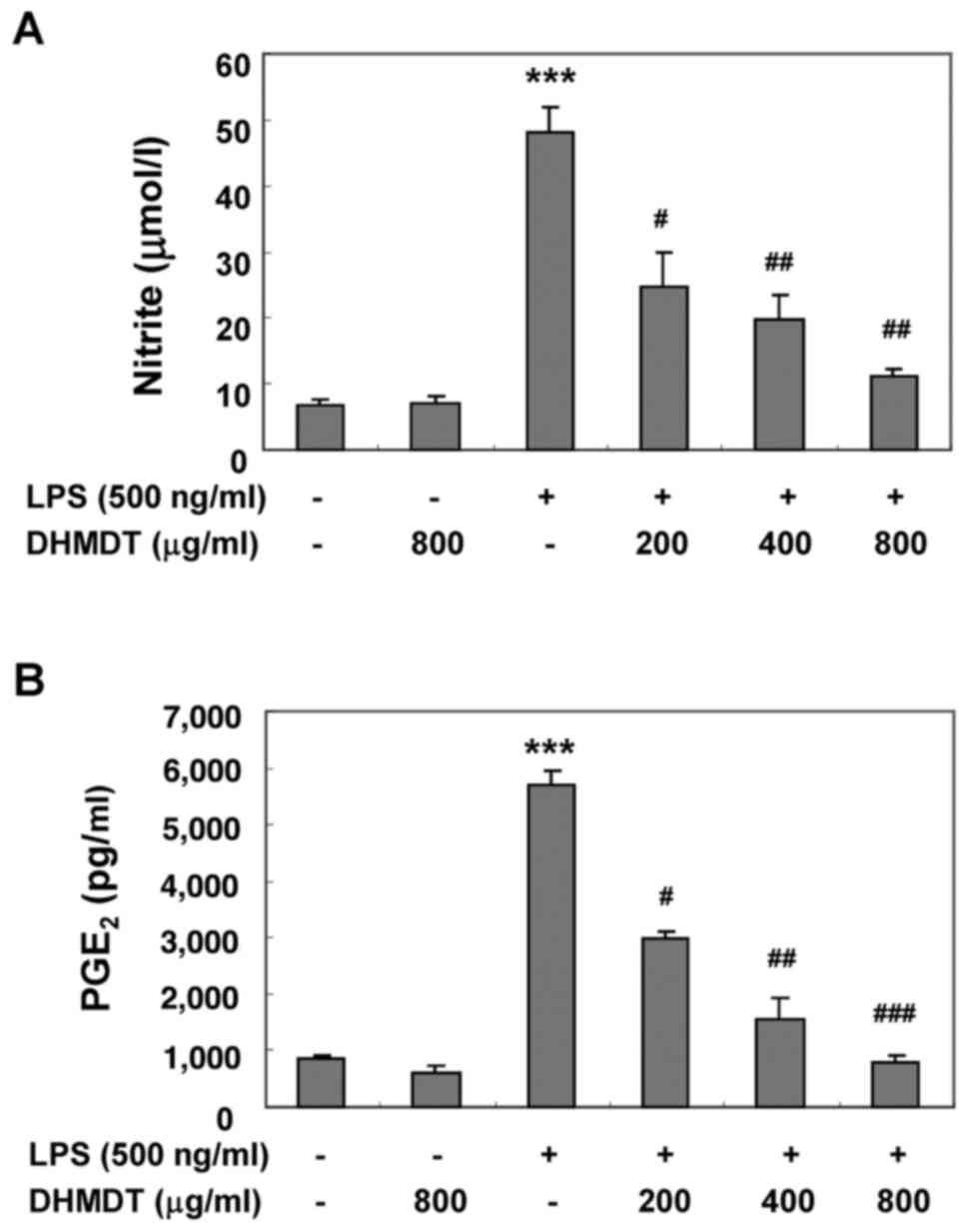 |
Figure 1
|
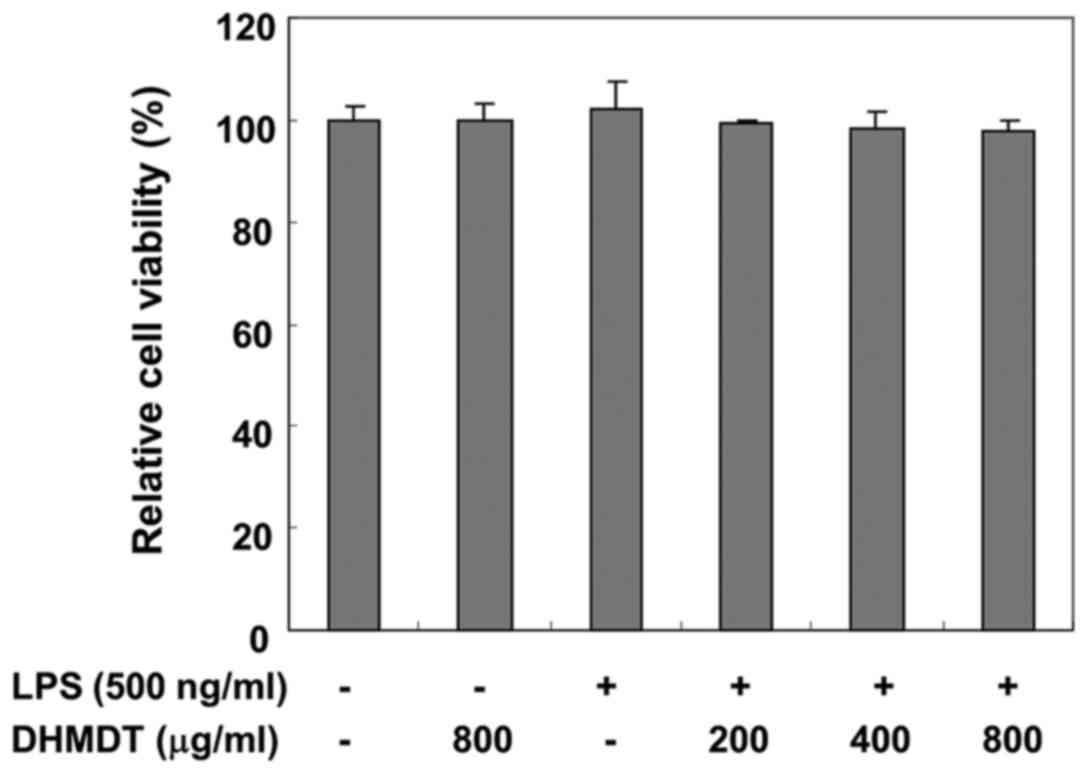 |
Figure 2
|
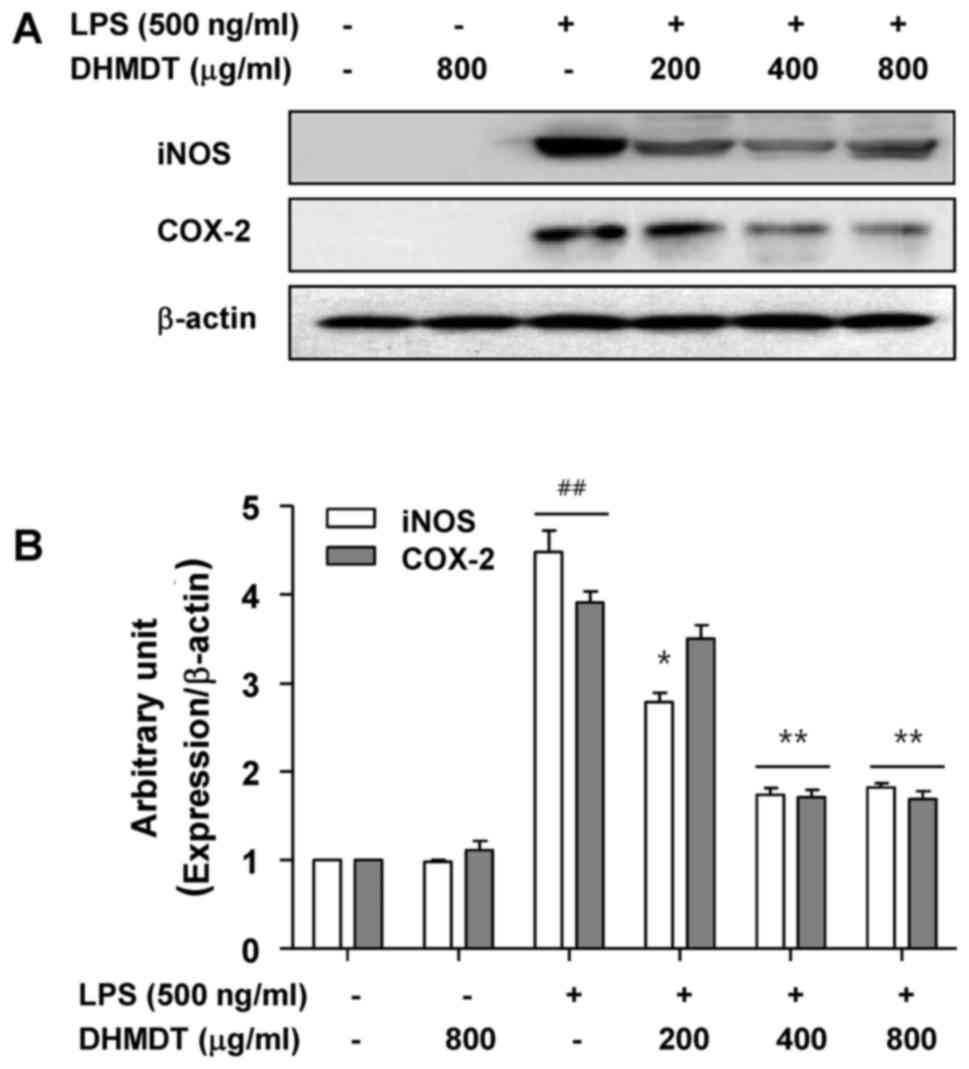 |
Figure 3
|
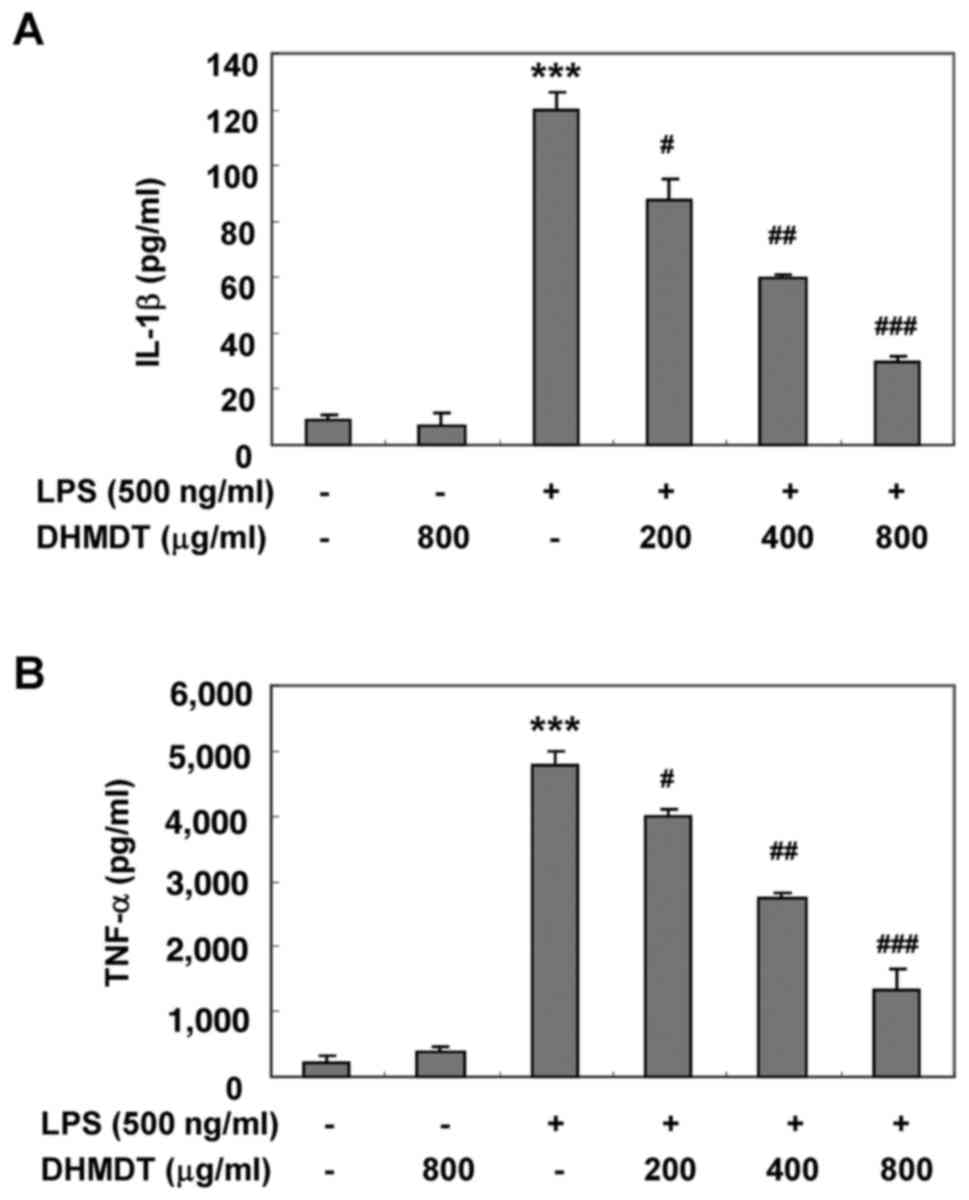 |
Figure 4
|
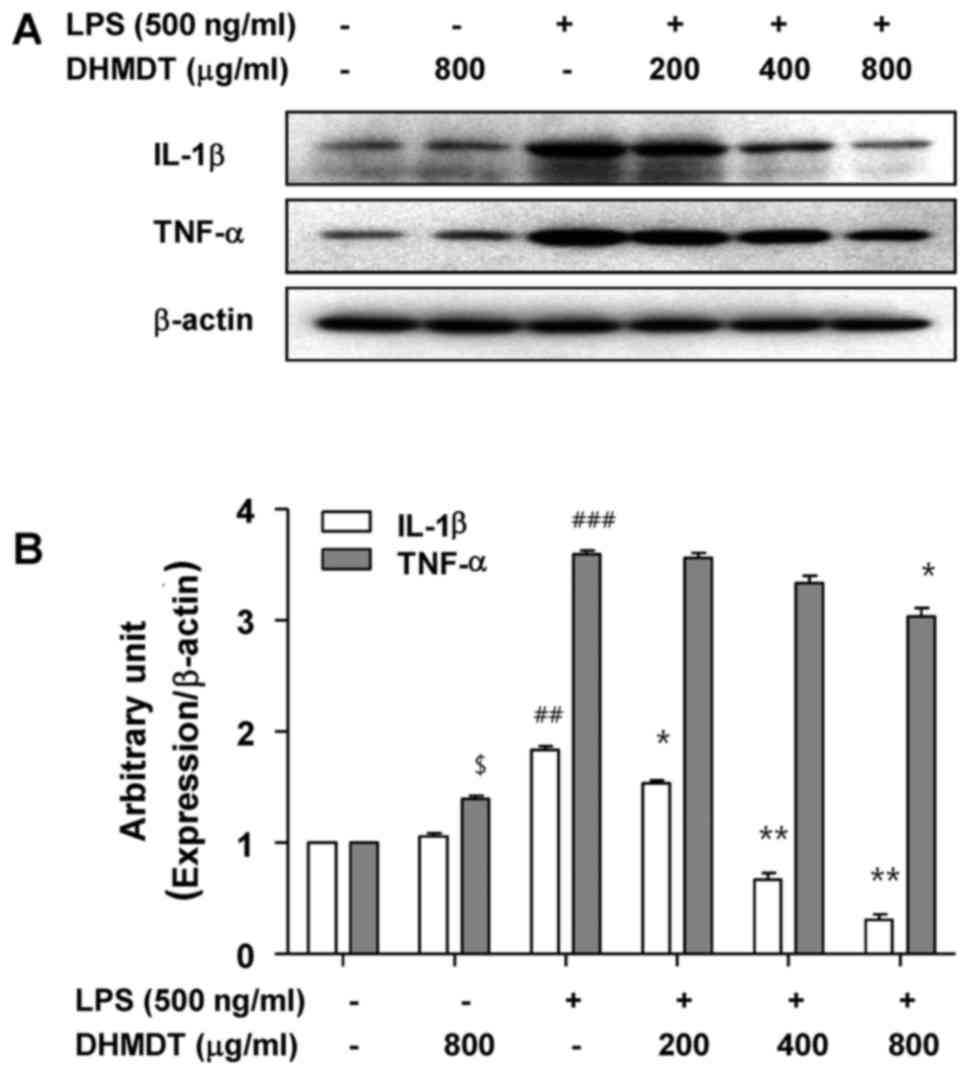 |
Figure 5
|
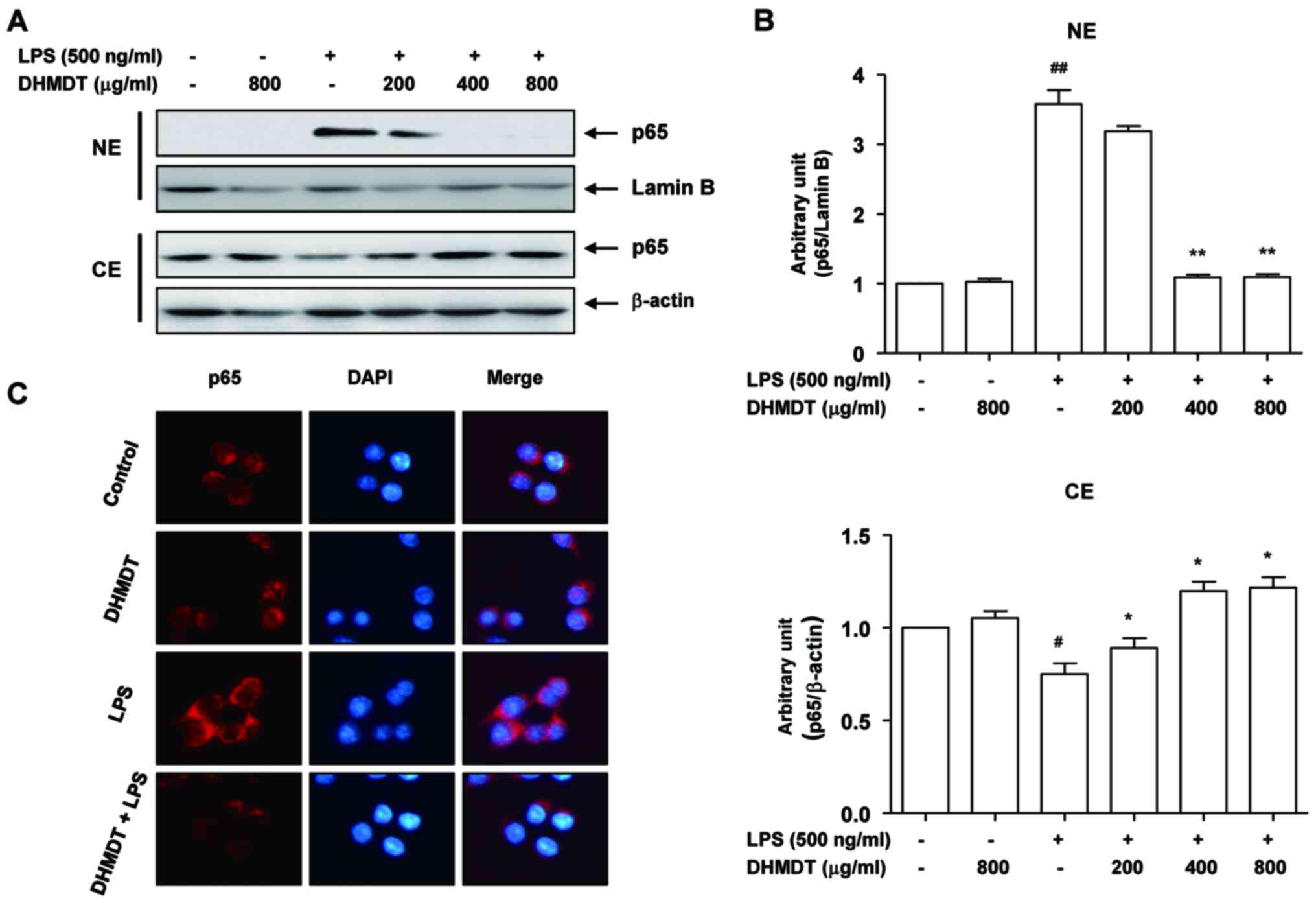 |
Figure 6
|
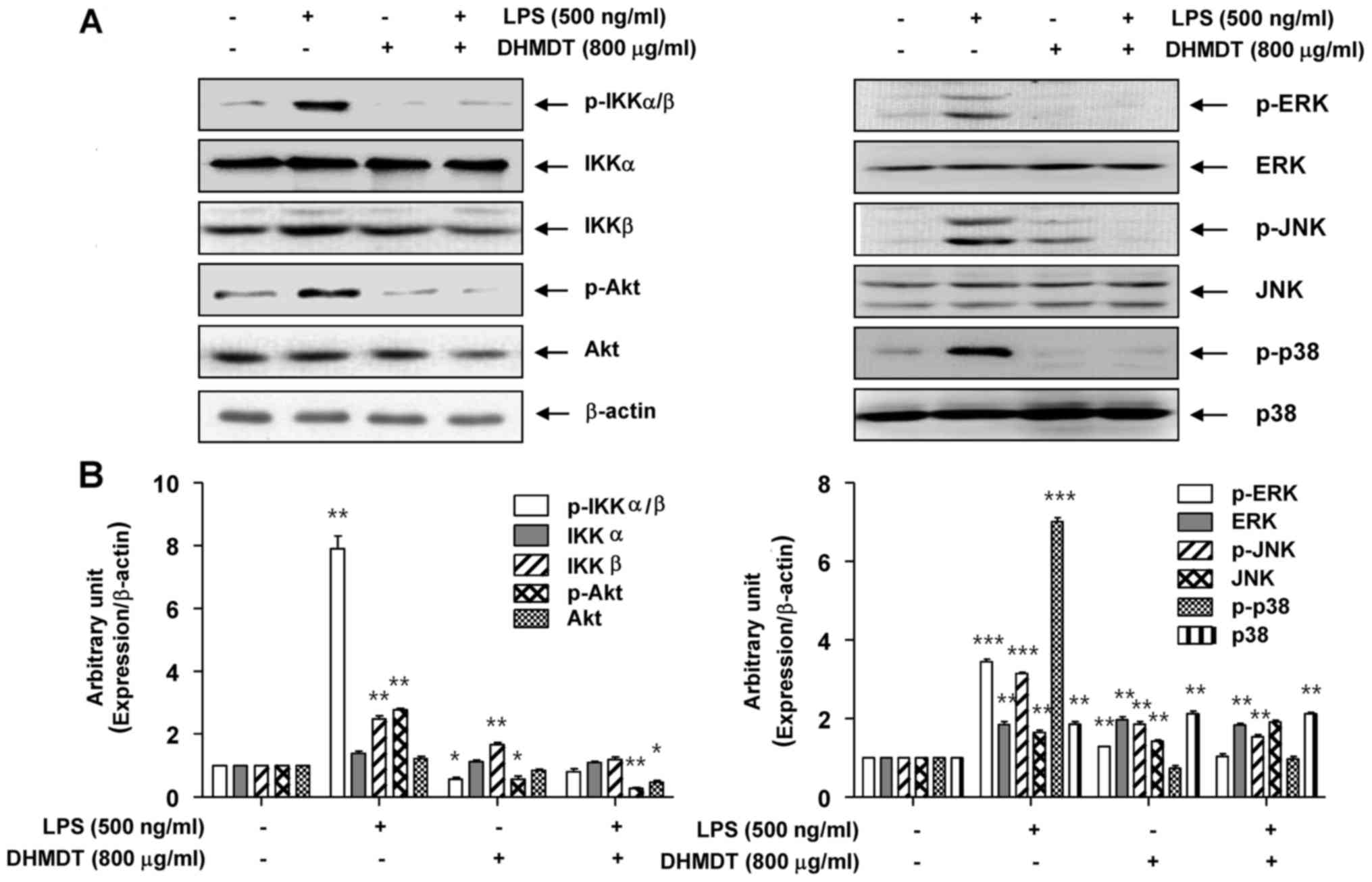 |
Figure 7
|
View References
|
1
|
Conti B, Tabarean I, Andrei C and Bartfai
T: Cytokines and fever. Front Biosci. 9:1433–1449. 2004. View Article : Google Scholar : PubMed/NCBI
|
|
2
|
Amin AR, Attur M and Abramson SB: Nitric
oxide synthase and cyclooxygenases: Distribution, regulation, and
intervention in arthritis. Curr Opin Rheumatol. 11:202–209. 1999.
View Article : Google Scholar : PubMed/NCBI
|
|
3
|
Zhang X and Mosser DM: Macrophage
activation by endogenous danger signals. J Pathol. 214:161–178.
2008. View Article : Google Scholar : PubMed/NCBI
|
|
4
|
Muralidharan S and Mandrekar P: Cellular
stress response and innate immune signaling: Integrating pathways
in host defense and inflammation. J Leukoc Biol. 94:1167–1184.
2013. View Article : Google Scholar : PubMed/NCBI
|
|
5
|
Verstrepen L, Adib-Conquy M, Kreike M,
Carpentier I, Adrie C, Cavaillon JM and Beyaert R: Expression of
the NF-kappaB inhibitor ABIN-3 in response to TNF and toll-like
receptor 4 stimulation is itself regulated by NF-kappaB. J Cell Mol
Med. 12:316–329. 2008. View Article : Google Scholar : PubMed/NCBI
|
|
6
|
Buchanan MM, Hutchinson M, Watkins LR and
Yin H: Toll-like receptor 4 in CNS pathologies. J Neurochem.
114:13–27. 2010.PubMed/NCBI
|
|
7
|
Li L, Jacinto R, Yoza B and McCall CE:
Distinct post-receptor alterations generate gene- and
signal-selective adaptation and cross-adaptation of TLR4 and TLR2
in human leukocytes. J Endotoxin Res. 9:39–44. 2003. View Article : Google Scholar : PubMed/NCBI
|
|
8
|
Broom OJ, Widjaya B, Troelsen J, Olsen J
and Nielsen OH: Mitogen activated protein kinases: A role in
inflammatory bowel disease? Clin Exp Immunol. 158:272–280. 2009.
View Article : Google Scholar : PubMed/NCBI
|
|
9
|
del Zoppo G, Ginis I, Hallenbeck JM,
Iadecola C, Wang X and Feuerstein GZ: Inflammation and stroke:
Putative role for cytokines, adhesion molecules and iNOS in brain
response to ischemia. Brain Pathol. 10:95–112. 2000. View Article : Google Scholar : PubMed/NCBI
|
|
10
|
McDaniel ML, Kwon G, Hill JR, Marshall CA
and Corbett JA: Cytokines and nitric oxide in islet inflammation
and diabetes. Proc Soc Exp Biol Med. 211:pp. 24–32. 1996,
View Article : Google Scholar : PubMed/NCBI
|
|
11
|
Li Q and Verma IM: NF-kappaB regulation in
the immune system. Nat Rev Immunol. 2:725–734. 2002. View Article : Google Scholar : PubMed/NCBI
|
|
12
|
Yenari MA and Han HS: Influence of
hypothermia on post-ischemic inflammation: Role of nuclear factor
kappa B (NFkappaB). Neurochem Int. 49:164–169. 2006. View Article : Google Scholar : PubMed/NCBI
|
|
13
|
Caivano M: Role of MAP kinase cascades in
inducing arginine transporters and nitric oxide synthetase in
RAW264 macrophages. FEBS Lett. 429:249–253. 1998. View Article : Google Scholar : PubMed/NCBI
|
|
14
|
Li X, Jiang S and Tapping RI: Toll-like
receptor signaling in cell proliferation and survival. Cytokine.
49:1–9. 2010. View Article : Google Scholar : PubMed/NCBI
|
|
15
|
Heo J and Kim KJ: Dongui Bogam.
Beopinmunhwasa Publishing Corp.; Seoul: 1999, (In Korean).
|
|
16
|
Fujihara M, Muroi M, Tanamoto K, Suzuki T,
Azuma H and Ikeda H: Molecular mechanisms of macrophage activation
and deactivation by lipopolysaccharide: Roles of the receptor
complex. Pharmacol Ther. 100:171–194. 2003. View Article : Google Scholar : PubMed/NCBI
|
|
17
|
Laveti D, Kumar M, Hemalatha R, Sistla R,
Naidu VG, Talla V, Verma V, Kaur N and Nagpal R: Anti-inflammatory
treatments for chronic diseases: A review. Inflamm Allergy Drug
Targets. 12:349–361. 2013. View Article : Google Scholar : PubMed/NCBI
|
|
18
|
Haddad JJ: The role of inflammatory
cytokines and NF-kappaB/MAPK signaling pathways in the evolution of
familial Mediterranean fever: Current clinical perspectives and
potential therapeutic approaches. Cell Immunol. 260:6–13. 2009.
View Article : Google Scholar : PubMed/NCBI
|
|
19
|
Saklatvala J: Inflammatory signaling in
cartilage: MAPK and NF-kappaB pathways in chondrocytes and the use
of inhibitors for research into pathogenesis and therapy of
osteoarthritis. Curr Drug Targets. 8:305–313. 2007. View Article : Google Scholar : PubMed/NCBI
|
|
20
|
Wei J and Feng J: Signaling pathways
associated with inflammatory bowel disease. Recent Pat Inflamm
Allergy Drug Discov. 4:105–117. 2010. View Article : Google Scholar : PubMed/NCBI
|
















